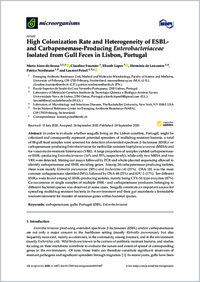High colonization rate and heterogeneity of ESBL- and carbapenemase-producing enterobacteriaceae isolated from gull feces in Lisbon, Portugal
- Aires-de-Sousa, Marta Emerging Antibiotic Resistance Unit, Medical and Molecular Microbiology, Faculty of Science and Medicine, University of Fribourg, CH-1700 Fribourg, Switzerland - Escola Superior de Saúde da Cruz Vermelha Portuguesa, 1300 Lisbon, Portugal - Laboratory of Molecular Genetics, Instituto de Tecnologia Química e Biológica António Xavier, Universidade Nova de Lisboa, 2780 Oeiras, Portugal
- Fournier, Claudine Emerging Antibiotic Resistance Unit, Medical and Molecular Microbiology, Faculty of Science and Medicine, University of Fribourg, CH-1700 Fribourg, Switzerland
- Lopes, Elizeth Laboratory of Molecular Genetics, Instituto de Tecnologia Química e Biológica António Xavier, Universidade Nova de Lisboa, 2780 Oeiras, Portugal
- Lencastre, Hermínia de Laboratory of Molecular Genetics, Instituto de Tecnologia Química e Biológica António Xavier, Universidade Nova de Lisboa, 2780 Oeiras, Portugal - Laboratory of Microbiology and Infectious Diseases, The Rockefeller University, New York, NY 10065, USA
- Nordmann, Patrice Emerging Antibiotic Resistance Unit, Medical and Molecular Microbiology, Faculty of Science and Medicine, University of Fribourg, CH-1700 Fribourg, Switzerland - Swiss National Reference Center for Emerging Antibiotic Resistance (NARA), CH-1700 Fribourg, Switzerland
- Poirel, Laurent Emerging Antibiotic Resistance Unit, Medical and Molecular Microbiology, Faculty of Science and Medicine, University of Fribourg, CH-1700 Fribourg, Switzerland - Swiss National Reference Center for Emerging Antibiotic Resistance (NARA), CH-1700 Fribourg, Switzerland
-
28.09.2020
Published in:
- Microorganisms. - 2020, vol. 8, no. 10, p. 1487
English
In order to evaluate whether seagulls living on the Lisbon coastline, Portugal, might be colonized and consequently represent potential spreaders of multidrug-resistant bacteria, a total of 88 gull fecal samples were screened for detection of extended- spectrum β-lactamase (ESBL)- or carbapenemase-producing Enterobacteriaceae for methicillin-resistant Staphylococcus aureus (MRSA) and for vancomycin-resistant Enterococci (VRE). A large proportion of samples yielded carbapenemase- or ESBL- producing Enterobacteriaceae (16% and 55%, respectively), while only two MRSA and two VRE were detected. Mating-out assays followed by PCR and whole-plasmid sequencing allowed to identify carbapenemase and ESBL encoding genes. Among 24 carbapenemase-producing isolates, there were mainly Klebsiella pneumoniae (50%) and Escherichia coli (33%). OXA-181 was the most common carbapenemase identified (54%), followed by OXA-48 (25%) and KPC-2 (17%). Ten different ESBLs were found among 62 ESBL-producing isolates, mainly being CTX-M-type enzymes (87%). Co-occurrence in single samples of multiple ESBL- and carbapenemase producers belonging to different bacterial species was observed in some cases. Seagulls constitute an important source for spreading multidrug-resistant bacteria in the environment and their gut microbiota a formidable microenvironment for transfer of resistance genes within bacterial species.
- Faculty
- Faculté des sciences et de médecine
- Department
- Médecine 3ème année
- Language
-
- English
- Classification
- Biological sciences
- License
- License undefined
- Identifiers
-
- RERO DOC 329781
- DOI 10.3390/microorganisms8101487
- Persistent URL
- https://folia.unifr.ch/unifr/documents/309047
Statistics
Document views: 80
File downloads:
- poi_hcr.pdf: 152
